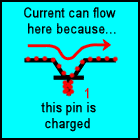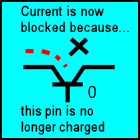TRANSISTORS |
A computer is packed with microscopic circuits allowing treatment of astronomical amounts of informations in splits of seconds. Its circuits contain numerous condensers and "switches". These last are transistors. A transistor is an electronic component with 3 pins: In, out, and a third one allowing to electrically control the flow between in and out. (See drawings). If that third pin is charged (at the state 1), the switch lets current flow between the 2 others. If it's not charged (state 0) the switch is open and current can no longer flow between in and out. A transistor is comparable to a tap. It could be said to be an "electronic tap".
One can start to envision the possibility of opening and closing switches to charge and discharge condensers and these condensers can serve as memory if they keep the state in which they have been put. This last sentence summarizes the basic working of a computer. More about this in the next page...
Orders of magnitude
It must
be said that the quantities associated with these electrons are impressive.
We can't see them yet we are able to master them. Based on the book
"Our
cosmical origins" by Armand Delsemme, Franois
Terrin (yes, that one is in french, Armand Delsemme is from Belgium)
says that these particles are spinning around the nucleus of an atom
at the speed of about 2,000 km/sec (a bit over 1,000 miles/sec) like
a planet around a tiny sun. So that this electron makes about 30 billions of
revolutions around the nucleus per millionth of second, same in one
second as an airplane propeller in 4 millions of years!
Thus it's
not surprising that a computer could perform a few hundreds of thousands
of calculations between the time a bullet was fired and the moment it
came out of the barrel. There would be plenty of time to change one's
mind more than once and finally decide to stop that bullet! It is these
orders of magnitude and that phenomenal speed which give information
technology its magic character and its power of treatment.
| |
|
| Copyright 2003-2004 Jacques Lederer |




